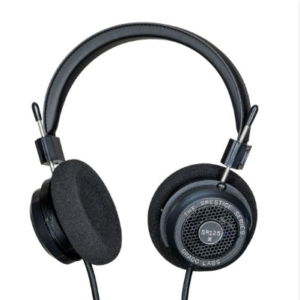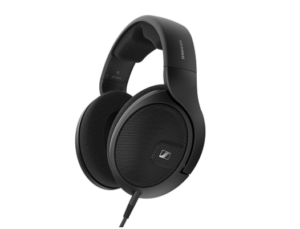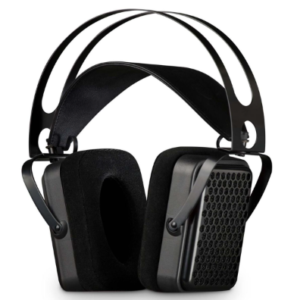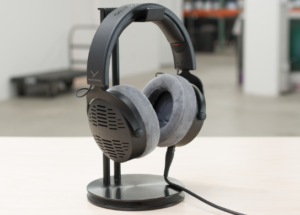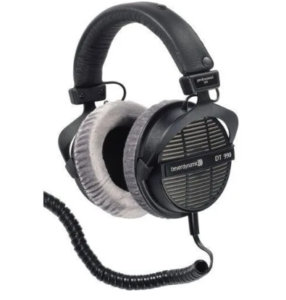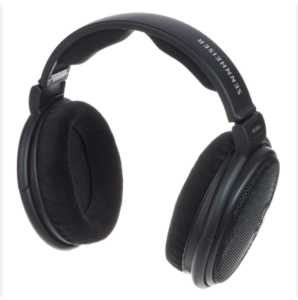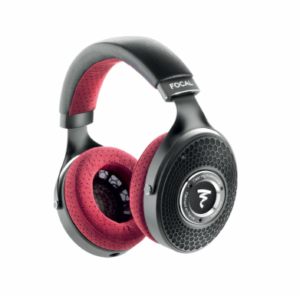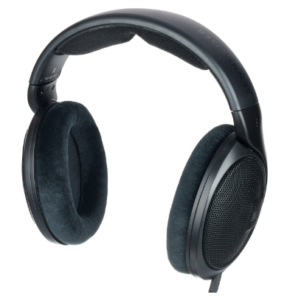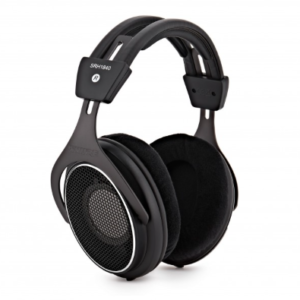To find the best open-back headphones for mixing and mastering, you need to carefully consider your options. Take a look at our list to make an informed decision.
These headphones each offer unique qualities that can improve your overall mixing and mastering experience.
9 Best Open-Back Headphones For Mixing
1. Grado SR125e
Meet the Grado SR125e open-back headphones! Equipped with dynamic drivers, they boast a frequency range of 20Hz to 20kHz, delivering clear and precise sound.
They also feature comfortable foam ear cups for long listening sessions without fatigue. The vented diaphragm design also reduces distortion.
Perfect for professionals! The detachable cable also allows you to easily upgrade or replace it to suit your preferences.
Grado has been making headphones since 1982. Their handcrafted design and high-quality materials ensure outstanding tonal balance, clarity, and accuracy.
No wonder they are the top choice for audio professionals around the world. Wearing these headphones will make you feel like you’re at a private concert, but with better sound quality.
2. Sennheiser HD 560S
Perfect for audiophiles who want analytical clarity without breaking the bank. With a neutral sound profile and excellent detail retrieval, they’re ideal for critical listening sessions, especially when mastering or enjoying high-resolution tracks.
The Sennheiser HD 560S are open-back headphones designed for neutral listening. They deliver a clear, detailed sound with excellent instrument separation and imaging, making them a great choice for critical listening.
Comfort is not an issue with the plush padded covers and soft foam, allowing you to wear them for long periods without discomfort.
The headphones are lightweight with a mostly plastic construction, but the non-standard cable connector may limit your cable replacement options.
The HD 560S offers impressive sound quality and comfort, but the bulky design and lack of onboard controls may be a drawback for some users.
However, if sound fidelity and comfort are your priorities, these headphones are worth considering at the sub-$200 price point.
3. Avantone Pro Planar
This is one of the weirder choices I’ve made on this list, but let me tell you why it might be a good choice.
If you haven’t heard of Avantone, they are the company that primarily designs the Mixcubes you see in some studios.
They serve as a secondary reference for your speaker monitors, showing you how your mix will sound on a more typical consumer sound system.
With a reputation in the pro audio space, they not only designed a reference open-back, but they made it planar.
The goal of this planar system is to achieve better accuracy than a simple moving coil with a much faster transient response.
On the other hand, you lose a bit of noise floor, and while you may want to hear it when making decisions in your mix, the frequency response is still flat.
I also want to point out that the Pro Planar is the most comfortable option on this list.
Not only are planar drivers much lighter than dynamic drivers, but wearing them can make you feel almost weightless for hours on end.
Long mixing sessions can be a lot easier when you don’t have to worry about ear fatigue.
For $399, this is a great deal, as it not only gives you a true reference but also gives you the luxury of an audiophile experience. It’s the perfect hybrid.
4. Beyerdynamic DT 900 Pro X
The Beyerdynamic DT 900 PRO X is a great choice for music professionals, audiophiles, and content creators.
The open design may leave some bass to be desired, but the balanced sound profile delivers excellent sound quality.
The soft velour ear pads and brushed metal headband make the headphones comfortable to wear for long periods of time.
However, the lack of a folding mechanism and limited earcup rotation limits their portability.
In terms of build quality, the DT 900 PRO X is more refined than its predecessor, well-constructed, and durable.
The headphones’ low impedance makes them easy to use without an external amplifier, making them ideal for a variety of applications.
The lack of bass may be a disadvantage for bass lovers, but the clear vocals and lead instruments enhance the overall listening experience.
Overall, the Beyerdynamic DT 900 PRO X headphones are a solid choice for those who prioritize sound quality and comfort over portability.
The luxurious design and practicality make them ideal for use in the studio or at home.
5. Beyerdynamic DT 990 Pro
Beyerdynamic describes the 990 as impressively spacious, with a wide stereo image and three-dimensional sound reproduction.
Based on the aforementioned characteristics, it’s safe to say that it would be an excellent choice for headphone mixing.
The main pitfall of headphone mixing is that you tend to monitor from about 6 inches away, making them too narrow!
The DT 990 seems to have solved that problem at least a little!
6. Sennheiser HD 660S
The Sennheiser HD 660S is the successor to the HD 650 studio headphones. It shares many similarities with its 600 series siblings but has been refined to suit critical listening.
The HD660S offers excellent clarity in the high and midrange with a hi-fi-oriented sound quality, while maintaining excellent transient response and soundstage.
The sound is similar to that of a near-field speaker, with excellent reproduction of instruments and vocals, and a soundstage wide enough to determine panning and compression.
The bass is solid but not overly boomy, which may be lacking for those accustomed to bass-heavy monitors or the best closed-back headphones.
The midrange and highs offer a pleasantly appropriate boost and cut without being overpowering or overwhelming.
This neutral sound, combined with the open design, helps to reduce ear fatigue even after prolonged use.
If you want a more fun-sounding HD 600, especially for checking the balance of the midrange and treble in dense mixes, the Sennheiser HD 660S is an interesting gift for those ears that are still critical enough to expose flaws in the mix.
7. Focal Clear MG Professional
Finally, here’s another high-end headphone from a manufacturer that specializes in studio monitors. Focal is notorious in the audiophile community for having some of the best high-end headphones available today.
The Clear is one of their most acclaimed models, and earlier this year they released a variant called the Clear MG Professional, designed for studio settings.
The Clear MG Pro uses M-shaped magnesium drivers for better tonal balance and a more complete frequency spectrum.
Like the HEDDphone, Focal has applied the same materials used in their monitors to the speaker drivers to bring it closer to a studio reference experience.
The construction of these headphones is also very solid, with each Focal headphone using the same construction, minus the Utopia, literally.
They offer incredible comfort for long mixing sessions and are a solid alternative to the HEDDphone if you really don’t like the monstrous earcups.
The cool, flat sound signature lets you see what’s going on in your mix without compromise, giving you a wide soundstage for critical listening.
At $1,490, they’re cheaper than the HEDDphone, but still a hefty price tag compared to most studio headphones. However, there are still not many headphones that are as accurate and refined as the Clear MG Professional.
8. Sennheiser HD 400 Pro
For a slightly more expensive but still under $300, the Sennheiser HD 400 Pro is amazing. They are durable, lightweight, and comfortable, and they sound really open, spacious, and, above all, natural.
For a fraction of the price of a speaker monitor, you can get some really high-quality mixes with these open-back headphones.
9. Shure SRH1840
The 1840 is a premium open headphone. Shure describes it as best suited for mastering or critical listening, with a frequency response of 10Hz to 35kHz, but it also has a strong following in the audiophile community.
It’s by no means cheap, but if quality is your thing, you can’t beat the Shure 1840s.
Things to Consider when Choosing the Best Headphones for Mixing and Mastering
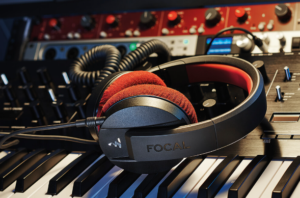
When choosing the right open-back headphones for mixing and mastering, it’s important to consider several factors. We cover a comprehensive breakdown of the key considerations.
1. Open-back vs. Closed-back Headphones
For those unfamiliar with open-back headphones, the primary design feature of these headphones is the open earcups.
This means that open-back headphones leak sound while also letting in ambient sounds.
For this reason, it’s important to consider whether you’ll be using your headphones for multiple purposes, such as recording, or for the sole purpose of mixing your tracks.
That is, if you’re looking to buy a reference headphone that’s optimized for mixing and monitoring purposes, you’ll want a closed-back headphone to keep sound out during your recording sessions.
2. Frequency Response
Most studio headphone manufacturers add a high-frequency rolloff because high frequencies are louder when they’re close to your ears.
They also add a bit of a bass boost to give you that thumping rhythm you hear from your monitor speakers.
You want to find headphones with the most neutral frequency response possible so that you can hear clear, natural audio in your mixes.
Most open-back headphones have an extended frequency range at both ends for a deeper response.
3. Comfort and Fit
The fit and comfort of open-back headphones are essential to a successful mixing and mastering process. They should be lightweight and adjustable to fit all head sizes, while not being too tight or too loose.
The ear pads should be soft to prevent sound leakage and reduce ear fatigue. Over-ear cups should provide complete sound immersion.
When choosing open-back headphones, consider the frame construction for durability and flexibility. Choose wired headphones over wireless headphones for a stable connection and lag-free monitoring.
Invest in a reputable brand for durable, high-quality headphones. Headphones will last longer than the Kardashians. Choose durability wisely.
4. Headphone Terminology
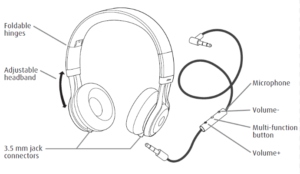
Clamp force determines the pressure or tightness of the ear cups against your ears.
Ideally, you want headphones that offer a consistent amount of clamp force that is neither too loose to easily fall off with minimal movement nor too tight to be uncomfortable.
Soundstage refers to the perception of the width and depth of sound coming from the headphone drivers. This reproduces the placement or imaging of instruments while listening.
This is important when listening to modern and remastered tracks.
Roll-off refers to the gradual attenuation (reduction in volume) that often occurs at the low or high end of the frequency range of headphones or speakers.
Transient response is how quickly the driver reacts to changes in audio.
Impedance is the amount of resistance that the headphones present to the source.
High-power amplifiers or interfaces can benefit from high-impedance headphones, while low-impedance headphones are easily driven by most interfaces and mobile devices.
It’s okay to run low-impedance headphones with a high-power interface or amplifier if you control the volume.
However, matching high-impedance headphones with low-power sound sources, such as cheap interfaces or mobile sources, can underdrive the drivers.
Cranking a low-power sound source can cause output stage distortion and affect your perception of the mix.
5. HRTF Plugins and Studio Simulators
In recent years, plugins have been developed to simulate studio environments on headphones. Initially, these were inaccurate stereo processors that only simulated the delay between the ears.
Later, HRTF plugins were developed to simulate the time delay based on the size and shape of the user’s head.
This usually required measurements of the user’s head. I’ve come across plugins like Tonebooster Isone Pro, 112dB Redline Monitor, Beyerdynamic Virtual Studio, and most recently Waves NX.
While they’re not a perfect replacement for a pair of studio monitors in a well-treated room, they do allow for some alternative monitoring situations.
Think of them as palette cleansers, especially when determining how loud certain layers can be in an acoustic environment.
These types of plugins have helped me translate many of my mixes to other systems. I usually go without plugins after the initial mix.
6. Price
For those thinking about the cost of open-back headphones, be practical. Consider usage, longevity, frequency response range, driver size, materials, and comfort level.
Don’t let price be the only factor when choosing headphones for mixing and mastering. Cost does not equal better performance.
Conclusion

Open-back headphones are generally best for mixing. The design allows for a more natural and airy sound than closed-back headphones, which is essential for critical listening.
Whether you’re on a budget or can afford more expensive ‘phones’, buy the best headphones you can afford and start learning!
Also read: Best Earbuds That Translate in Real-Time

